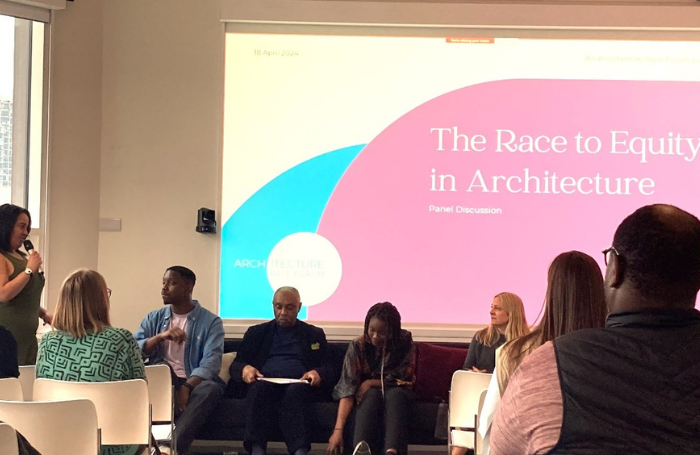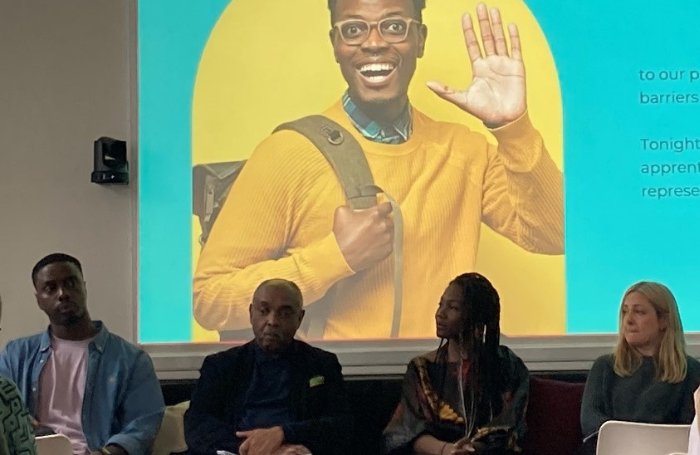On Thursday 18 April, the Architecture Race Forum held its first panel event for 2024: The Race to Equity in Architecture. This thought-provoking panel discussion, held at AHMM studios in London, focussed on education, apprenticeship recruitment and industry representation. RIBA’s Inclusion and Diversity Specialist, Lienkie Diedericks, who attended the event, shares key take away points and actions from the evening.
The Architecture Race Forum is a group of architects across the UK committed to empowering the architecture industry with tools to increase diversity, whether a single practitioner or a sizable practice, and to celebrate and inspire a positive shift in this space. The forum aims ‘to help create a profession where underrepresented ethnic minorities have equitable opportunities to study, work and progress their professional careers’. Panel speakers included:
- Wilfred M Achille - co-course leader in architecture, University of Westminster
- Funmbi Adeagbo - Project Architect, Morris and Company
- Jason Claxton - Director, FOUND Careers and Trustee at Found Futures
- Rebecca Roberts-Hughes - Director of Policy and Communications, Architects’ Registration Board
The panel was moderated by Rochelle Dalphinis, lead of the Architecture Race Forum and interior designer, stylist and diversity and inclusion groundbreaker, and Muhammed Khan, Director and Board Member at Mission Critical: Data Centre Sector.

Social mobility: a key barrier
The discussion started off with some key findings from the Architects Registration Board presented by Rebecca Roberts-Hughes. Positive changes in diversity are happening, especially on a university level, but Black and Asian architects remain underrepresented in the profession, especially outside of London and the south east of England.
In response to these figures, the impact of social mobility on students from minoritised ethnic backgrounds emerged as one of the key factors in understanding and addressing the barriers that minoritised students face in progressing into architecture.
Panellists spoke about the role of social mobility not only in terms of students having the financial means to support themselves during the long architectural training but also having the social capital to progress through the profession. Without the right contacts, navigating from Part 1 to Part 3 becomes an uphill battle.
Apprenticeships: an alternative?
In addressing barriers created by social mobility, one of the central questions that panellists engaged with was whether apprenticeships are the catalyst for a more diverse architectural profession.
Although apprentices have a greater technical understanding and expertise than many of those graduating from the more traditional routes of education, there is a concern that there is still a stigma in the UK around apprenticeships being perceived as second class. This stigma seems to be an extension of preconceived notions about the value of a potential candidate depending on whether they have attended the ‘right kind’ of university, such as a Russell Group institution.
Yet, as Jason Claxton noted, apprenticeships hold promise and are likely to affect the profession positively. Their ability to fast track technical skills and project experience could potentially level the playing field. However, it will be essential for architectural practices to undergo a mind shift about the value of apprenticeships. This mind shift involves addressing conscious and unconscious biases about race, ethnicity, social mobility and gender that challenge the very idea of what an ‘ideal architect’ looks and sounds like.
Find out more about architecture apprenticeships.

Mind the gap: from education to the workplace
The topic of apprenticeships raised another key issue: the gap between education and practice. As Funmbi Adeagbo noted, universities must adopt a more up-to-date approach to architectural education, and businesses need to be more transparent about what is truly required at a technical level in the workplace.
For example, panellists suggested that higher education providers do not focus on training students in a variety of essential technologies, practice management and workflow techniques – all of which are essential to a 21st century architectural practice. As a result, only students from privileged backgrounds, who can afford additional support and training, can use these technologies and employ certain technical skills when they reach the workplace. This disproportionately disadvantages students from minoritised ethnic backgrounds.
How can we make architecture more equitable?
1. Be empathetic and curious about candidates and colleagues
Try and look for something in candidates (and colleagues) that will prompt you to self-reflect as a business: where can we do better?
2. Focus on the retention and progression of diverse talent
This requires nurturing talent, and shifting the focus from equality of opportunity to equity. Be sure to monitor which roles colleagues from minoritised ethnic backgrounds hold, whether they are listened to at key decision-making points, and how they are progressing. Without nurturing and monitoring, a diverse recruitment programme alone is tokenism.
3. Recognise the role of mentorship and sponsorship
If you are a more senior member of staff (whether you are from a minoritised ethnic background or not) you can play a positive role in someone's life and help them to build networks. In this way, leadership is not determined by rank, but rather by the willingness to make way for someone else.
4. Become comfortable with diversity
The wider demographic of architects and professionals must become more comfortable with diversity and equity in the workplace. This involves stepping up to support young architects who need it, being open to what this additional support might mean and being receptive to non-traditional design ideas and practices.
Connect with the Architecture Race Forum on LinkedIn and at archraceforum@gmail.com.









